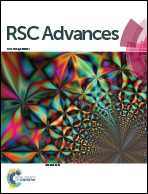Dialkoxyphenyldithiophene-based small molecules with enhanced absorption for solution processed organic solar cells†
Abstract
Compared to the popular benzodithiophene (BDT) unit, dialkoxyphenyldithiophene (PDT) has the advantages of increased planarity along the molecular backbone (decreased dihedral angles between PDT and π bridges) and stronger donating ability, which may lead to better absorption, higher hole mobility and even higher power conversion efficiency (PCE). In this paper, two small molecules (CNO2TPDT and RD2TPDT) with PDT unit as a donor, bithiophene (2T) as π bridges, and oxoalkylated nitrile (CNO) or 3-ethylrhodanine (RD) as end-capped acceptors were synthesized and characterized. As expected, CNO2TPDT and RD2TPDT showed excellent absorption with edges of 720 and 745 nm, respectively, which are red-shifted by ca. 30 nm compared with their BDT analogues. A CNO2TPDT-based device exhibited relatively high Voc of 0.87 V but a low PCE of 4.16% due to a large phase separation. In contrast, a RD2TPDT-based device exhibited higher PCE of 6.64% with a Jsc of 12.74 mA cm−2 due to its red-shift absorption, better miscibility with [6,6]-phenyl-C71 butyric acid methylester (PC71BM) and higher hole mobility. This study demonstrated rational molecule design and effective morphology control can lead to good absorption ability and hole mobility, indicating the possibility for obtaining higher Jsc and PCE.


 Please wait while we load your content...
Please wait while we load your content...